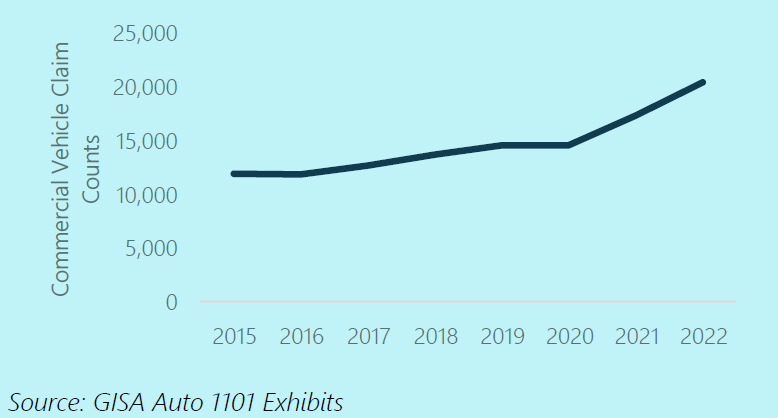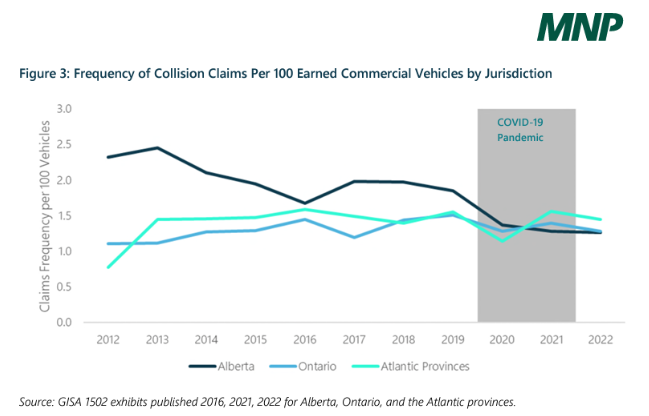Canada-wide spike in insurance claims calls for enhanced training, oversight: Report
The number of insurance claims for all commercial vehicles across Canada increased ‘significantly faster’ than the number of commercial vehicles on the road between 2016 and 2022, according to the Commercial Trucking Insurance and Education report released Tuesday.
The Insurance Bureau of Canada (IBC) commissioned MNP, one of Canada’s professional services firms, to identify the key factors impacting the cost of insurance for commercial truck operators.

The data for this study was collected between June 2023 and January 2024, and one of the key suggestions outlined by MNP and IBC is that entry-level training has to be followed by onboarding and mentorship programs, with the funding for the programs’ development and administration provided through partnerships between insurers, carriers, and governments.
“The property and casualty insurance industry is working closely with the trucking sector to find solutions to some of the challenges it currently faces, including driver shortages and access to adequate training and risk management,” said Celyeste Power, IBC’s president and chief executive officer, in a news release.
Accident rates and premiums
The report found that insurance premiums are highly correlated with claims expenses and the risk of a claim being made.
Experience and claims expenses are the largest contributor to increases in premiums, and less experienced drivers – especially those driving for under three years – have a higher chance of getting into an accident. Driver experience and the length of time since a previous claim are correlated with claim frequency and severity.
To illustrate the impact of safety improvements on claim costs, MNP estimated the reduction in claim costs for each accident avoided by Alberta logging truck drivers with three years of experience.
In 2015, each accident that was avoided would have led to a substantial reduction in claim costs per policy, estimated to be around $581.80.
However, between 2016 and 2018, the situation changed. During this period, each avoided accident would have resulted in a much smaller reduction in claim costs per policy, ranging between $100 and $125, which can be attributed to the increase in claim frequency and severity over time.

When it comes to the third-party liability claims frequency, Alberta tops the list and is followed by Ontario and the Atlantic provinces, even though Alberta’s claims frequency per 100 vehicles was decreasing before the pandemic.
In 2021, Ontario and the Atlantic Provinces saw an increase in collision claims frequency relative to 2020, while the trend in Alberta remained relatively stable.
Cargo type & cross-border trips
Additionally, collisions involving heavy loads or dangerous goods tend to be more severe and have a greater damage potential. As a result, the level of required liability coverage increases when these goods are transported, affecting premiums.
Traveling across the border adds zeros to the premiums, too, due to the risks of exposure to ‘nuclear’ jury verdicts. Consequently, premiums for vehicles traveling outside of Canada are increasing.
“Interviewees identified this as a concern for all Canadian jurisdictions, but it was of particular concern in Alberta,” the report reads.
Training leaves something to be desired
However, despite the difference in types and frequencies of claims across the provinces, commercial vehicle safety in Canada is a joint federal, provincial, and territorial responsibility.
This is why MNP has examined regulatory, training and operating environments on a provincial and federal level in the report.
The research has shown that even though roadside inspections and facility audits lead to increased compliance with safety measures, the enforcement of commercial truck violations is inadequate.
While most National Safety Code (NSC) standards have been implemented, the entry-level training is different across the provinces.
MNP adds that the existing entry-level training in Canada is not designed to fully prepare drivers for operating heavy trucks in all conditions.
“Entry-level programs are intended to provide exposure to the industry and basic skills to pass the Class 1 test. They do not cover the full range of competencies required of drivers, which means that graduating drivers do not yet have the full set of skills required to be road ready.”
In addition, the training quality varies by school, and MNP recommends improving oversight of training providers across the country.
“There is inconsistency in how entry-level training is delivered and not all schools provide training consistent with the defined standards,” the report reads. “There needs to be oversight, and standards need to be enforced.”
Telematics and progressive licensing
Other recommendations include piloting the use of telematics to provide feedback to commercial truck drivers, since that has the potential to reduce the cost of onboarding and mentorship.
And while as of now there is no consensus on whether telematics is effective at increasing driver safety, a pilot project could address this gap.
Meanwhile, piloting the use of graduated or progressive licensing would allow new drivers to gain experience gradually, starting with restricted driving conditions and advancing to more complex scenarios over time, the recommendations added.
“We look forward to working together on the items identified in this report and other projects currently underway as we develop a comprehensive road map to address key policy issues in Canada impacting trucking operations, safety, training, licensing and industry oversight,” said Geoff Wood, Canadian Trucking Alliance’s senior vice-president of policy, in a news release.
Philip Fletcher, the president of the Truck Training Schools Association of Ontario, added that the report’s findings substantially represent what the association has experienced in training over the past several years.
Have your say
This is a moderated forum. Comments will no longer be published unless they are accompanied by a first and last name and a verifiable email address. (Today's Trucking will not publish or share the email address.) Profane language and content deemed to be libelous, racist, or threatening in nature will not be published under any circumstances.
-
Well said I say we should limit all foreign students ( drivers) from all countries except 9 like new Zealand Australia U K , Holland etc to rural farm loads for the first season or after doing the melt program be limited to D class of 60 000 lbs or less or 25 passengers or less . Bring them in late Jan train ready to start driving on their in in a D class to Dec then send them back bring back next April. It is not safe to have 20 plus foreign students who have a job as a truck driver from a country like does not take safety seriously.
Until a government road test becomes a real test and “schools” – (yeah, I’m implying Brampton) only need to “train” for the test, perhaps we need to rely on the insurance industry and quality carriers to say, “unless you go to an approved, proper, full training institution, you will not be considered for employment”
Re: Humboldt – the gov’t gave him a licence
-
We need to stop all trucking companies from running self insurance or running a captive .Ont and Alberta need to follow the Manitoba or British Columbia model of gov insurance and limit new truck drivers and use a professional training program .
I have instructed for almost 7 years at the post secondary level in a trade, and have taught in-house for many more years. I have found that quality instruction is often not the goal of training institutions, it is simply to get people in the class and get their money.
I do not agree with the idea that we need more training institutions. We need more people willing and committed to learn.
My formal training to drive a transport truck was at best 2-3 days, and one of those days was learning about air brakes. However I was always watching and listening to other more experienced truckers to learn as much as I could. It was made very clear to me when I started that I was responsible for the truck and load and everyone around me. I realized that it was a large responsibility, so I learned.( I have driven off and on again for well over 30 years [3-8 axles] on and off hiway.)
The notion that we have to be taught to learn is at best an incomplete theory of learning and at worst a foolish conclusion.
I have found that the ability for the average student to think critically has plummeted. This I think is from following all the “latest craze” in “learning theories” that is common in public schools.
There are two huge problems haunting the trucking industry and will continue to do so until they are resolved:
Number 1:
I don’t know how it is in other provinces, but Alberta has great commercial driver educational standards, but almost ZERO enforcement, relying on the integrity of the schools to do “the right thing”. Many of the schools are shirking their responsibilities in an effort to grab the almighty dollars and are not being punished for it because there are no consequences as it stands now. (I have heard that this problem exists in Ontario as well)
Number 2:
Once a student has completed a course, he or she still needs “onboarding” at their employer, however employers are reticent to hire new grads because their insurance companies are basically saying “No”, either by raising premiums or making rules that require 2-3 years of experience as an employment requirement, creating the “Catch-22” for the new driver.
While we are working on training for new drivers, we need to develop training for existing drivers to become coaches and Mentors so they are available to the new driver when he graduates MELT. Very Few companies have programs to develop the new graduate and take him from the tractor trailer licensing training , then into the work place training. The senior driver needs upgrade training about compliance, teaching adults, personal interaction, lesson planning and job skills to become coach. As Coach he can then aspire to the Red Seal designation . the red seal designation cannot be descibed until we develop trucking sectors and can describe the skill sets and equivalencies of the job performed by the driver in each of the sectors. I.E. dry van, flat deck, lowboy, dry bulk, liquid bulk, cattle liner, pneumatic, heavy haul, special equipment, concrete mixer, roll on roll off, log haul, oil field and its subsets, vac truck, dump box,,,,,,,,,,,,, we need to build support for driver development across the board to provide the path to safety and improved skill sets, then consequently Driver Recognition.
It won’t change until such time as we have proper driver training schools.
It has to be removed from “for profit” schools and be government run vocational training schools.
When we did have vocational schools offering driver training, the graduates were actually hireable on short haul and city work.
Now we have schools selling certification and unscrupulous haulers putting those green horns on highway long distance operations
WRONG!